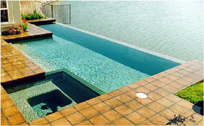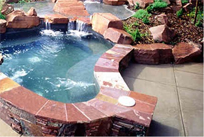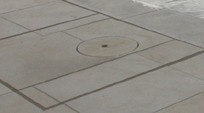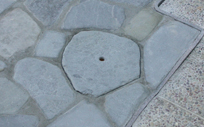Making Skimmer Lids Vanish

Of all the visual distractions we’ve considered so far in this series of articles, the one I will discuss here might be the detail I could most safely skip. After all, the necessity of making skimmer lids less visually intrusive has been part of dozens of articles published in WaterShapes – most notably in several by David Tisherman, who has been on a crusade to get other designers and builders to hide these doohickeys for at least the dozen years I’ve known him.
However tempting it is to give the subject a rest and move along, I will include this step here anyway – partly  to be thorough, but more so because not everyone seems to
to be thorough, but more so because not everyone seems to  have gotten the point. In fact, I still see photographs of pool projects that have big white dots set into otherwise acceptable deckwork (Figures 1 & 2).
have gotten the point. In fact, I still see photographs of pool projects that have big white dots set into otherwise acceptable deckwork (Figures 1 & 2).
It’s a crying shame, especially because it’s so simple to avoid this particular visual trap.
Too Many Options?
I’m just guessing, but I’ve always suspected that some watershapers get off the righteous path of skimmer-lid concealment because there are so many decking options out there and they succumb to the allure of a one-size-fits-all, “this isn’t something I want to worry about” mentality as they march through their projects.
As I have pointed out time and again in these newsletter articles, in classes and in magazines, that’s taking the easy way out: You’re leaving your clients to live with something that will bother them endlessly, even if it’s only on a subconscious level. Humans, we know, prefer visual consistency, and a white skimmer lid set amid a field of stone, exposed aggregate, brick or wood stands out like the sorest of sore thumbs.
So from the beginning of any project, I decide how I’m going to address these particular visual eyesores and make them go away.
 If it’s to be a stone deck, I will cut a stone lid. If it’s an exposed aggregate deck, I will order a skimmer lid that has a recessed tray that will hold a matching swath of exposed aggregate. If my client wants a wood deck, I’ll build a trap door. You get the picture: Whatever the deck system, there’s a solution that makes it possible to help skimmer lids do a disappearing act (Figure 3).
If it’s to be a stone deck, I will cut a stone lid. If it’s an exposed aggregate deck, I will order a skimmer lid that has a recessed tray that will hold a matching swath of exposed aggregate. If my client wants a wood deck, I’ll build a trap door. You get the picture: Whatever the deck system, there’s a solution that makes it possible to help skimmer lids do a disappearing act (Figure 3).
With a deep stainless steel tray pierced by a couple drain holes, for example, you can drop in a slug of sod and conceal skimmer access with grass or a ground cover. If you have good control of how a material like brick will lay out, a similar tray approach can be used with that material as well. And all that any of these methods takes is a small bit of planning and making certain the skimmer’s throat is aligned at the proper elevation to accommodate the solution you’ve selected.
In my classes, I refer to putting lids on skimmers as a round of “Where’s Waldo?” – although in my case I want to make these lids almost impossible to find. And to a large extent I succeed, convinced that this game is simple enough that everyone should learn to play it (and win it) the right way. It’s an important part of the art of concealment and is yet another way to please your clients with only a minor investment of time and care.
Next: Hiding the sources of illumination.
Paolo Benedetti is principal at Aquatic Technology Pool & Spa, a design/build firm based in Morgan Hill, Calif. He may be reached at [email protected].










